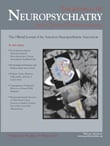To the Editor: Subacute sclerosing panencephalitis is a slow virus infection of the CNS caused by defective measles virus. Typically, subacute sclerosing panencephalitis presents in childhood or early adolescence, but adult-onset cases are recognized.
1 Four cases of childhood (between 8 and 13 years old) and four cases of adult-onset (between 19 and 37 years old) subacute sclerosing panencephalitis presenting with psychosis were reported between 1988 and 2003.
2 –
5 We report the unusual late presentation of a 31-year-old man who was first diagnosed with first-episode schizophrenia but who was finally shown to have subacute sclerosing panencephalitis.
Case Report
The patient, a mathematics teacher with no family or past history of psychiatric or neurologic illness, was referred because of apathy and paranoid delusions. His medical history was only remarkable for having measles when he was 9 years old. The first symptom of the patient was nervousness that began 1 year before his admission. Six months previously he began to complain of difficulty in solving mathematic problems. One month before being admitted to our clinic, the patient was referred to an outpatient neurology clinic with symptoms of apathy, bradykinesia, and bizarre behaviors. In his physical examination, evidence of a mild level of parkinsonism and cognitive dysfunction was found. Laboratory results were unremarkable. CT and MRI scans of the brain and EEG were normal at that time. Psychiatric evaluation of the patient revealed his delusions of reference, mind reading and persecution, and depressive mood. The patient was hospitalized, and treatment with olanzapine, 10 mg/day, was begun.
Four days later, the olanzapine dose was gradually increased to 30 mg/day. On the next day the patient began to have catatonic symptoms of waxy flexibility, rigidity, mutism, bradykinesia, and urinary incontinence, and lorazepam treatment, 7.5 mg/day, was started. There was no improvement in his clinical status after 6 days of treatment; therefore we discontinued lorazepam and planned ECT. After eight sessions of ECT with no improvement, the patient further consulted with neurologists. A repeated EEG revealed periodic complexes and dysfunction of organization in frontal regions bilaterally, which are compatible with subacute sclerosing panencephalitis. The patient was transferred to an inpatient neurology clinic, and olanzapine was discontinued.
In his neurological examination, apathetic appearance, uncooperative behavior, bilateral rigidity of the upper extremities, sphincter dysfunction, and myoclonic jerks were apparent. Oligoclonal band was positive; CSF IgG index was 4 (normal <0.7). The CSF immunological study tested positive in high titers for IgG measles antibody. Repeated MRI scan did not reveal any abnormality. Diagnosis of subacute sclerosing panencephalitis was established according to these clinical, laboratory, and EEG findings.
Although subacute sclerosing panencephalitis is a rare condition in adults, our case suggests the importance of differential diagnosis in patients with first-episode psychosis.

